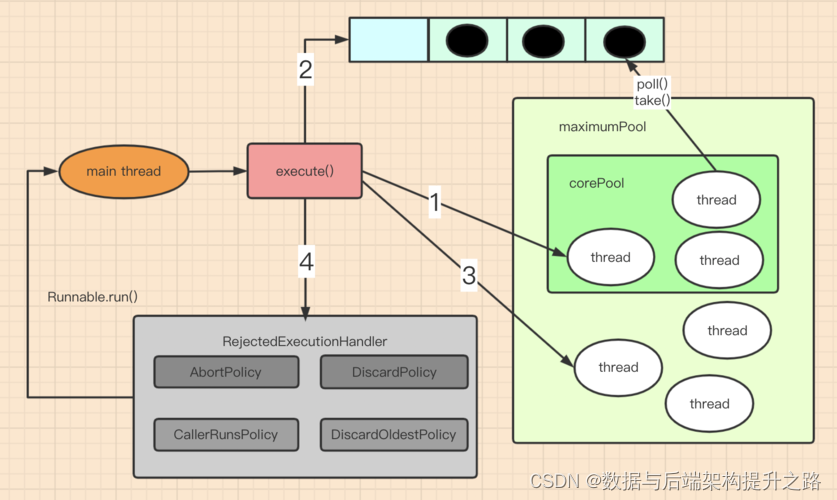Coding面试题之手写线程池
原理图

实现代码
1.线程类(PoolThread)
这个类用于执行任务队列中的任务。
public class PoolThread extends Thread {private final Queue<Runnable> taskQueue;private boolean isStopped = false;private long lastTaskTime = System.currentTimeMillis();public PoolThread(Queue<Runnable> queue) {taskQueue = queue;}public void run() {while (!isStopped()) {try {Runnable task;synchronized (taskQueue) {// 等待任务while (taskQueue.isEmpty() && !isStopped()) {taskQueue.wait();}if (isStopped()) break;task = taskQueue.poll();}task.run();lastTaskTime = System.currentTimeMillis(); // 更新上次任务完成的时间} catch (Exception e) {// 异常处理}}}public synchronized void stopThread() {isStopped = true;this.interrupt(); // 中断线程}public synchronized boolean isStopped() {return isStopped;}public boolean isIdleFor(long keepAliveTime) {return (System.currentTimeMillis() - lastTaskTime) > keepAliveTime;}
}
这里的“空闲时间”通常是指自线程上次执行任务以来经过的时间,而不是线程的创建时间。目的是为了确定线程是否在一段时间内没有被用于执行任何任务。
2.线程池类(ExtendedThreadPool)
这个类用于管理线程和任务的分配。
import java.util.ArrayList;
import java.util.LinkedList;
import java.util.List;
import java.util.Queue;
import java.util.Timer;
import java.util.TimerTask;public class ExtendedThreadPool {private final Queue<Runnable> taskQueue;private final List<PoolThread> threads;private boolean isStopped;private int maxNumThreadSize;private int minNumThreadSize;private int keepAliveTime;private Timer maintainTimer;public ExtendedThreadPool(int minNumThreadSize, int maxNumThreadSize, int keepAliveTime) {this.minNumThreadSize = minNumThreadSize;this.maxNumThreadSize = maxNumThreadSize;this.keepAliveTime = keepAliveTime;this.taskQueue = new LinkedList<>();this.threads = new ArrayList<>();this.isStopped = false;this.maintainTimer = new Timer();for (int i = 0; i < this.minNumThreadSize; i++) {threads.add(new PoolThread(taskQueue));}for (PoolThread thread : threads) {thread.start();}maintainThreadPool();}public synchronized void execute(Runnable task) {if (this.isStopped) throw new IllegalStateException("ThreadPool is stopped");this.taskQueue.add(task);this.taskQueue.notify();if (threads.size() < maxNumThreadSize) {PoolThread newThread = new PoolThread(taskQueue);threads.add(newThread);newThread.start();}}private void maintainThreadPool() {maintainTimer.schedule(new TimerTask() {@Overridepublic void run() {synchronized (taskQueue) {// 如果任务多于线程,且线程数小于最大线程数,则增加线程if (!taskQueue.isEmpty() && taskQueue.size()> threads.size() && threads.size() < maxNumThreadSize) {PoolThread newThread = new PoolThread(taskQueue);threads.add(newThread);newThread.start();}// 检查线程是否超过空闲时间,如果是,则移除线程Iterator<PoolThread> iterator = threads.iterator();while (iterator.hasNext()) {PoolThread thread = iterator.next();if (thread.isIdleFor(keepAliveTime)) {iterator.remove();thread.stopThread();}}}}}, 0, keepAliveTime * 1000);
}public synchronized void stop() {this.isStopped = true;for (PoolThread thread : threads) {thread.stopThread();}maintainTimer.cancel();}
}
上面的代码如何保证线程复用?
任务到达时唤醒: 当一个新任务被添加到队列中并且队列之前是空的,
execute方法会调用taskQueue.notify(),这会唤醒一个正在等待的线程。被唤醒的线程随后会从队列中取出任务(Runnable)并执行。线程不立即终止: 线程在执行完一个任务后不会立即终止。相反,它会再次检查队列是否有新的任务。如果有,线程会继续执行新的任务。一个线程在其生命周期内可以执行多个任务,而不是每完成一个任务就销毁并创建一个新的线程。
相关文章
【精选】线程池的核心参数和运行机制_线程池的核心参数以及工作机制-CSDN博客
线程池内运行的线程抛异常,线程池会怎么办_线程池线程异常后会结束线程吗-CSDN博客
